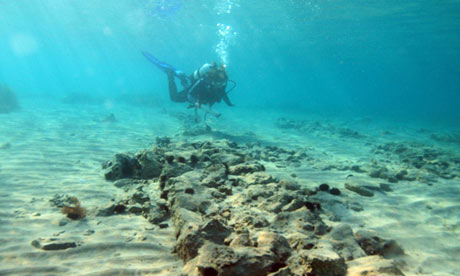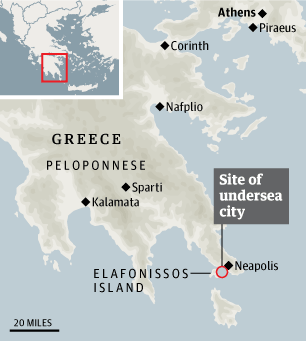Lost Greek city that may have inspired Atlantis myth gives up secrets
- guardian.co.uk, Friday 16 October 2009 19.49 BST
- Article history

A diver explores the sunken settlement beneath the waters off southern Greece. Photograph: Handout
The secrets of a lost city that may have inspired one of the world's most enduring myths – the fable of Atlantis – have been brought to light from beneath the waters off southern Greece.
Explored by an Anglo-Greek team of archaeologists and marine geologists and known as Pavlopetri, the sunken settlement dates back some 5,000 years to the time of Homer's heroes and in terms of size and wealth of detail is unprecedented, experts say.
"There is now no doubt that this is the oldest submerged town in the world," said Dr Jon Henderson, associate professor of underwater archaeology at the University of Nottingham. "It has remains dating from 2800 to 1200 BC, long before the glory days of classical Greece. There are older sunken sites in the world but none can be considered to be planned towns such as this, which is why it is unique."
The site, which straddles 30,000 square meters of ocean floor off the southern Peloponnese, is believed to have been consumed by the sea around 1000 BC. Although discovered by a British oceanographer some 40 years ago, it was only this year that marine archaeologists, aided by digital technology, were able to properly survey the ruins.
What they found surpassed all expectations. Thanks to shifting sands and the settlement's enclosure in a protected bay, the exploration revealed a world of buildings, courtyards, main streets, rock-cut tombs and religious structures. In addition, the seabed was replete with thousands of shards of pottery.

"We found ceramics dating back to the end of the stone age, which suggested that the settlement was occupied some 5,000 years ago, at least 1,200 years earlier than originally thought," said Henderson, who co-directed the underwater survey.
"Our investigations also revealed over 9,000 square meters of new buildings. But what really took us by surprise was the discovery of a possible megaron, a monumental structure with a large rectangular hall, which also suggests that the town had been used by an elite, and automatically raised the status of the settlement."
More than any other underwater site so far, the find offers potential insights into the workings of Mycenaean society.
"It is significant because as a submerged site it was never reoccupied," said Elias Spondylis, who co-directed the survey as the head of Greece's underwater antiquities department. "As such it represents a frozen moment of the past."
Marine geologists have yet to work out why the settlement sank. Theories include sea level changes, ground subsidence as the result of earthquakes, or a tsunami.
"It is very likely a combination of the first two," said Dimitris Sakellariou, at the Greek Institute of Oceanography. "As the world's oldest submerged city it is truly amazing. It not only shows how people lived at the time is also of great interest to natural scientists because the waters around it are so shallow."
Locals in the nearby town of Neapolis are delighted. "Older generations always knew something was there but we had no idea about the extent of it," said Neapolis's mayor, Yiannis Kousoulis.
It is the first time a sunken city has been found in Greece that predates the time that Plato wrote his allegorical tale of the sunken continent of Atlantis.
"Atlantis was a myth but it is a myth that keeps underwater exploration going," said Sakellariou. "Less than 1% of the world's ocean floors have ever been surveyed. This is an extraordinary find but there is still a lot more down there that has to be found."